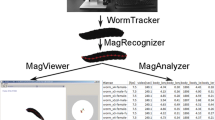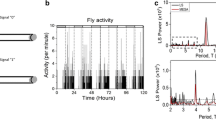Abstract
Free-running locomotor activity and eclosion rhythms ofDrosophila melanogaster, mutant at thedisconnected (disco) locus, are substantially different from the wild-type phenotype. Initial periodogram analysis revealed little or no rhythmicity (Dushayet al., 1989). We have reanalyzed the locomotor activity data using high-resolution signal analysis (maximum-entropy spectral analysis, or MESA). These analyses, corroborated by autocorrelograms, uncovered significant residual circadian rhythmicity and strong ultradian rhythms in most of the animals tested. In this regard thedisco mutants are much like flies expressing mutant alleles of theperiod gene, as well as wild-type flies reared throughout life in constant darkness. We hypothesize that light normally triggers the coupling of multiple ultradian oscillators into a functional circadian clock and that this process is disrupted indisco flies as a result of the neural lesion.
Similar content being viewed by others
References
Bargiello, T. A., Saez, L., Baylies, M., and Spray, D. (1987). TheDrosophila clock geneper affects intercellular junctional communication.Nature 328:686–691.
Bünning, E. (1973).The Physiological Clock, 2nd ed., Springer-Verlag, New York.
Chatfield, C. (1980).The Analysis of Time Series, 2nd Ed., Chapman and Hall, London.
Citri, Y., Colot, H. V., Jacquier, A. C., Yu, Q., Hall, J. C., Baltimore, D., and Rosbash, M. (1987). A family of unusually spliced and biologically active transcripts is encoded by aDrosophila clock gene.Nature 326:42–47.
Dowse, H. B., and Ringo, J. M. (1987). Further evidence that the circadian clock inDrosophila is a population of coupled ultradian oscillators.J. Biol. Rhythms 2:65–76.
Dowse, H. B., and Ringo, J. M. (1989a). RearingDrosophila in constant darkness produces phenocopies ofperiod circadian clock mutants.Physiol. Zool. (in press).
Dowse, H. B., and Ringo, J. M. (1989b). The search for hidden periodicities in biological time series revisited.J. Theor. Biol. (in press).
Dowse, H. B., Hall, J. C. and Ringo, J. M. (1987). Circadian rhythms inperiod mutants ofDrosophila melanogaster.Behav. Genet. 17:19–35.
Dushay, M. S., Rosbash, M., and Hall, J. C. (1989). Thedisconnected visual system mutations inDrosophila melanogaster drastically disrupt circadian rhythms.J. Biol. Rhythms J. Biol. Rhythms 4:1–27.
Engelmann, W., and Honegger, H. W. (1966). Tagesperiodische Schlupferrhythmik einer augenlosenDrosophila melanogaster—Mutante.Naturwissenschaften 53:588.
Enright, J. T. (1965). The search for hidden periodicities in biological time series.J. Theor. Biol. 8:426–468.
Hall, J. C., and Rosbash, M. (1987). Genetic and molecular analysis of biological rhythms.J. Biol. Rhythms 2:153–178.
Hamblen, M., Zehring, W. A., Kyriacou, C. P., Reddy, P., Yu, Q., Wheeler, D. A., Zwiebel, L. A., Konopka, R. J., Rosbash, M., and Hall, J. C. (1986). Germ-line transformation involving DNA from theperiod locus inDrosophila melanogaster: Overlapping genomic fragments that restore circadian rhythmicity ofper o andper − mutants.J. Neurogenet. 3:249–291.
Hamming, R. W. (1983).Digital Filters, 2nd ed., Prentice-Hall, Engelwood Cliffs, N.J.
Helfrich, C. (1986). Role of the optic lobes in the regulation of the locomotor activity rhythm ofDrosophila melanogaster: Behavioral analysis of neural mutants.J. Neurogenet. 3:321–343.
Helfrich, C., and Engelmann, W. (1983). Circadian rhythm of the locomotor activity inDrosophila melanogaster mutants “sine oculis” and “small optic lobes.”Physiol. Entomol. 8:257–272.
Helfrich, C., and Engelmann, W. (1987). Evidences for circadian rhythmicity in theper o mutant ofDrosophila melanogaster.Z. Naturforsch. 42c:1335–1338.
Jackson, F. R. (1983). The isolation of biological rhythm mutations on the autosomes ofDrosophila melanogaster.J. Neurogenet. 1:3–15.
Jackson, F. R., Bargiello, T. A., Yun, S.-H., and Young, M. W. (1986). Product ofper ofDrosophila shares homology with proteoglycans.Nature 320:185–188.
Konopka, R. J. (1980). Effects ofDrosophila photoreceptor mutations on the circadian activity rhythm.Soc. Neurosci. Abstr. 6:706.
Konopka, R. J. (1987). Neurogenetics ofDrosophila circadian rhythms. In Huettel, M. J. (ed.),Evolutionary Genetics of Invertebrate Behavior, Plenum Press, New York, pp. 215–221.
Konopka, R. J., and Benzer, S. (1971). Clock mutants ofDrosophila melanogaster.Proc. Natl. Acad. Sci. USA 68:2112–2116.
Oatley, K., and Goodwin, B. C. (1971). The explanation and investigation of biological rhythms. In Colquhoun, W. P. (ed.),Biological Rhythms and Human Performance, Academic Press, London and New York, pp. 1–38.
Page, T. L. (1982). Extraretinal photoreception in entrainment and photoperiodism in invertebrates.Experientia 38:1007–1013.
Pak, W. L. (1979). Study of photoreceptor function usingDrosophila mutants. In: Breakefield, X. O. (ed.),Neurogenetics: Genetic Approaches to the Nervous System, Elsevier/North-Holland, New York, pp. 67–99.
Palmer, J. D. (1967). Daily and tidal components in the persistent rhythmic activity of the crabSesarma.Nature 215:64–66.
Reddy, P., Jacquier, A. C., Abovich, N., Petersen, G., and Rosbash, M. (1986). Theperiod clock locus of D. melanogaster codes for a proteoglycan.Cell 46:53–61.
Rusak, B. (1977). The role of the suprachiasmatic nuclei in the generation of circadian rhythms in the golden hamster,Mesocricetus auratus.J. Comp. Physiol. 118:145–164.
Rusak, B. (1979). Neural mechanisms for entrainment and generation of mammalian circadian rhythms.Fed. Proc. 38:2589–2595.
Steller, H., Fischbach, K. F., and Rubin, G. (1987).disconnected: A locus required for neuronal pathway formation in the visual system of Drosophila.Cell 50:1139–1153.
Sulzman, F. M. (1982). Microcomputer monitoring of circadian rhythms.Comput. Biol. Med. 12:253–261.
Weitzel, G., and Rensing, L. (1981). Evidence for cellular circadian rhythms in isolated fluorescent dye-labelled salivary glands of wild-type and an arrhythmic mutant ofDrosophila melanogaster.J. Comp. Physiol. 143:229–235.
Winfree, A. T. (1980).The Geometry of Biological Time, Springer-Verlag, New York.
Yu, Q., Jacquier, A. C., Citri, Y., Colot, H. V., Hamblen, M., and Hall, J. C. (1987). Molecular mapping of point mutations in theperiod gene that stop or speed up biological clocks inDrosophila melanogaster.Proc. Natl. Acad. Sci. USA 84:784–788.
Author information
Authors and Affiliations
Additional information
This work was supported in part by NIH Grant FM-33205.
Rights and permissions
About this article
Cite this article
Dowse, H.B., Dushay, M.S., Hall, J.C. et al. High-resolution analysis of locomotor activity rhythms indisconnected, a visual-system mutant ofDrosophila melanogaster . Behav Genet 19, 529–542 (1989). https://doi.org/10.1007/BF01066252
Received:
Accepted:
Issue Date:
DOI: https://doi.org/10.1007/BF01066252




